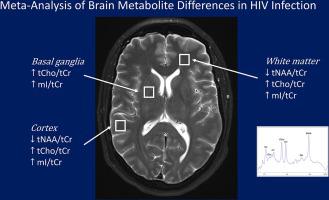NeuroImage: Clinical ( IF 4.2 ) Pub Date : 2020-09-15 , DOI: 10.1016/j.nicl.2020.102436 Lydia Chelala 1 , Erin E O'Connor 1 , Peter B Barker 2 , Thomas A Zeffiro 1

|
Background
Numerous studies have used magnetic resonance spectroscopy (MRS) neurometabolite measurements to study HIV infection effects. While many have reported differences in total N-Acetylaspartate (tNAA), myo-Inositol (mI), and total Choline (tCho), there have been no meta-analyses performed to evaluate concordance across studies.
Purpose
To evaluate the consistency of HIV serostatus effects on brain metabolites.
Study selection
The sample included studies conducted between 1993 and 2019 reporting HIV infection effects measured using proton MRS. tNAA/tCr ratios (21 papers), tCho/tCr ratios (21 papers), mI/tCr ratios (17 papers) and quantitative tCr (9 papers), sampling from basal ganglia (BG), gray matter (GM), and white matter (WM) were included.
Data analysis
Random effects meta-analysis using inverse variance weighting and bias corrected standardized mean differences (SMDs) was used. Meta-regression examined effects of publication year and data acquisition technique differences.
Data synthesis
BG SMDs related to positive serostatus were −0.10 [−0.39; 0.18] tNAA/tCr, 0.27 [0.05; 0.49] tCho/tCr, 0.60 [0.31; 0.90] mI/tCr, and −0.26 [−0.59; 0.06] tCr. GM SMDs related to serostatus were −0.29 [−0.49; −0.09] tNAA/tCr, 0.37 [0.19; 0.54] tCho/tCr, 0.41 [0.15; 0.68] mI/tCr, and −0.24 [−0.45; −0.03] tCr. WM SMDs related to serostatus were −0.52 [−0.79; −0.25] tNAA/tCr, 0.41 [0.21; 0.61] tCho/tCr, 0.59 [0.24; 0.94] mI/tCr, and −0.03 [−0.25; 0.19] tCr. WM regions showed larger serostatus effect sizes than BG and GM. I2 ranged from 52 to 88% for the metabolite ratios. Both GM and WM tNAA/tCr SMDs were lower with increasing calendar year.
Limitations
Many studies pooled participants with varying treatment, infection, and comorbidity durations.
Conclusions
HIV neurometabolite studies showed consistently lower tNAA/tCr, higher tCho/tCr and higher mI/tCr ratios associated with chronic HIV infection. Substantial between-study variation may have resulted from measurement technique variations, study population differences and HIV treatment changes over time. Higher WM tCho/tCr and mI/tCr may reflect reactive gliosis or myelin turnover. Neurometabolite measurements can reliably detect chronic HIV infection effects and may be useful in understanding the pathophysiology of cognitive and sensorimotor decline following HIV infection.
Classification of evidence
This study provides Class II evidence of neurometabolite differences in chronic HIV infection.
中文翻译:

艾滋病毒感染者脑代谢物差异的荟萃分析
背景
许多研究已经使用磁共振波谱(MRS)神经代谢物测量来研究HIV感染的影响。尽管许多人报告了总N-乙酰乙酰天冬氨酸(tNAA),肌醇(mI)和总胆碱(tCho)的差异,但并未进行荟萃分析来评估研究之间的一致性。
目的
评估艾滋病毒血清状态对脑代谢物的一致性。
研究选择
该样本包括1993年至2019年进行的研究,报告了使用质子MRS测量的HIV感染影响。tNAA / tCr比率(21篇论文),tCho / tCr比率(21篇论文),mI / tCr比率(17篇论文)和定量tCr(9篇论文),来自基底神经节(BG),灰质(GM)和白色样本物质(WM)也包括在内。
数据分析
使用逆方差加权和偏倚校正的标准化均值差(SMD)进行随机效应荟萃分析。元回归分析了出版年份和数据获取技术差异的影响。
数据综合
与阳性血清状况有关的BG SMD为-0.10 [-0.39; 0.18] tNAA / tCr,0.27 [0.05;0.49] tCho / tCr,0.60 [0.31; 0.90] mI / tCr和-0.26 [-0.59; 0.06]吨铬。与血清状况有关的GM SMD为-0.29 [-0.49; -0.09] tNAA / tCr,0.37 [0.19;0.54] tCho / tCr,0.41 [0.15;0.68] mI / tCr,和-0.24 [-0.45; -0.03] tCr。与血清状况有关的WM SMD为-0.52 [-0.79; -0.25] tNAA / tCr,0.41 [0.21;0.61] tCho / tCr,0.59 [0.24; 0.94] mI / tCr和-0.03 [-0.25; 0.19] tCr。西药区显示出比BG和GM更大的血清反应效应。I 2的代谢物比率为52%至88%。GM和WM tNAA / tCr SMD都随着日历年的增加而降低。
局限性
许多研究汇集了具有不同治疗,感染和合并症持续时间的参与者。
结论
HIV神经代谢物研究显示,与慢性HIV感染相关的tNAA / tCr,tCho / tCr和mI / tCr比率始终较低。研究之间的重大差异可能是由于测量技术的差异,研究人群的差异以及艾滋病治疗随时间的变化而引起的。较高的WM tCho / tCr和mI / tCr可能反映了反应性胶质增生或髓鞘更新。神经代谢物测量可以可靠地检测出慢性HIV感染的影响,可能有助于了解HIV感染后认知和感觉运动下降的病理生理。
证据分类
这项研究为慢性HIV感染中神经代谢物差异提供了II类证据。



























 京公网安备 11010802027423号
京公网安备 11010802027423号